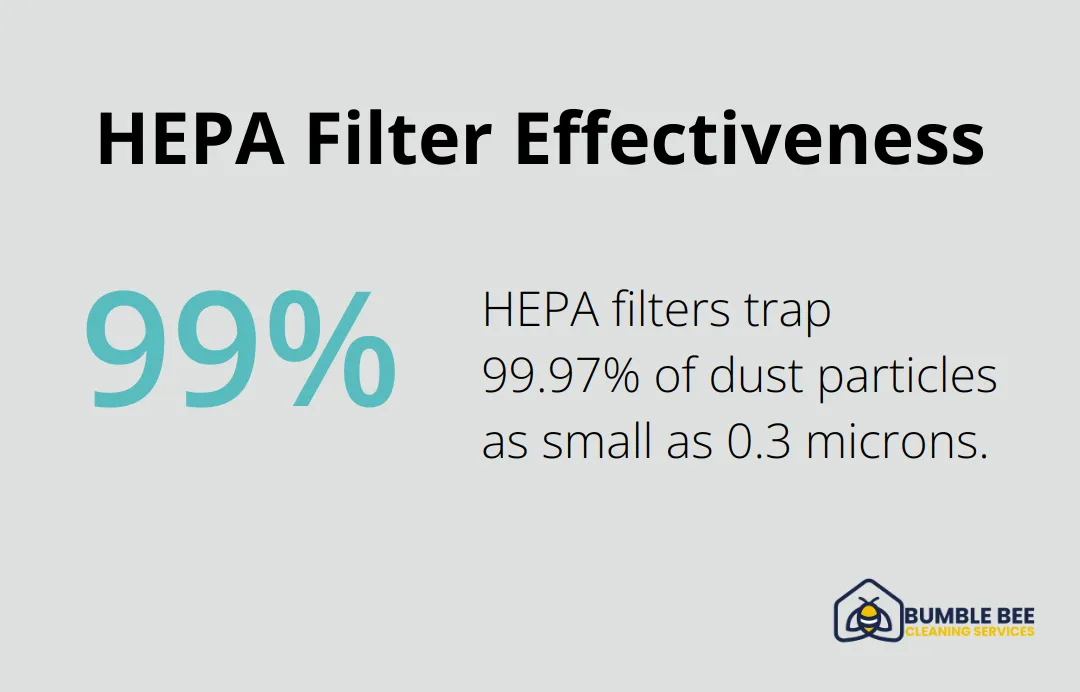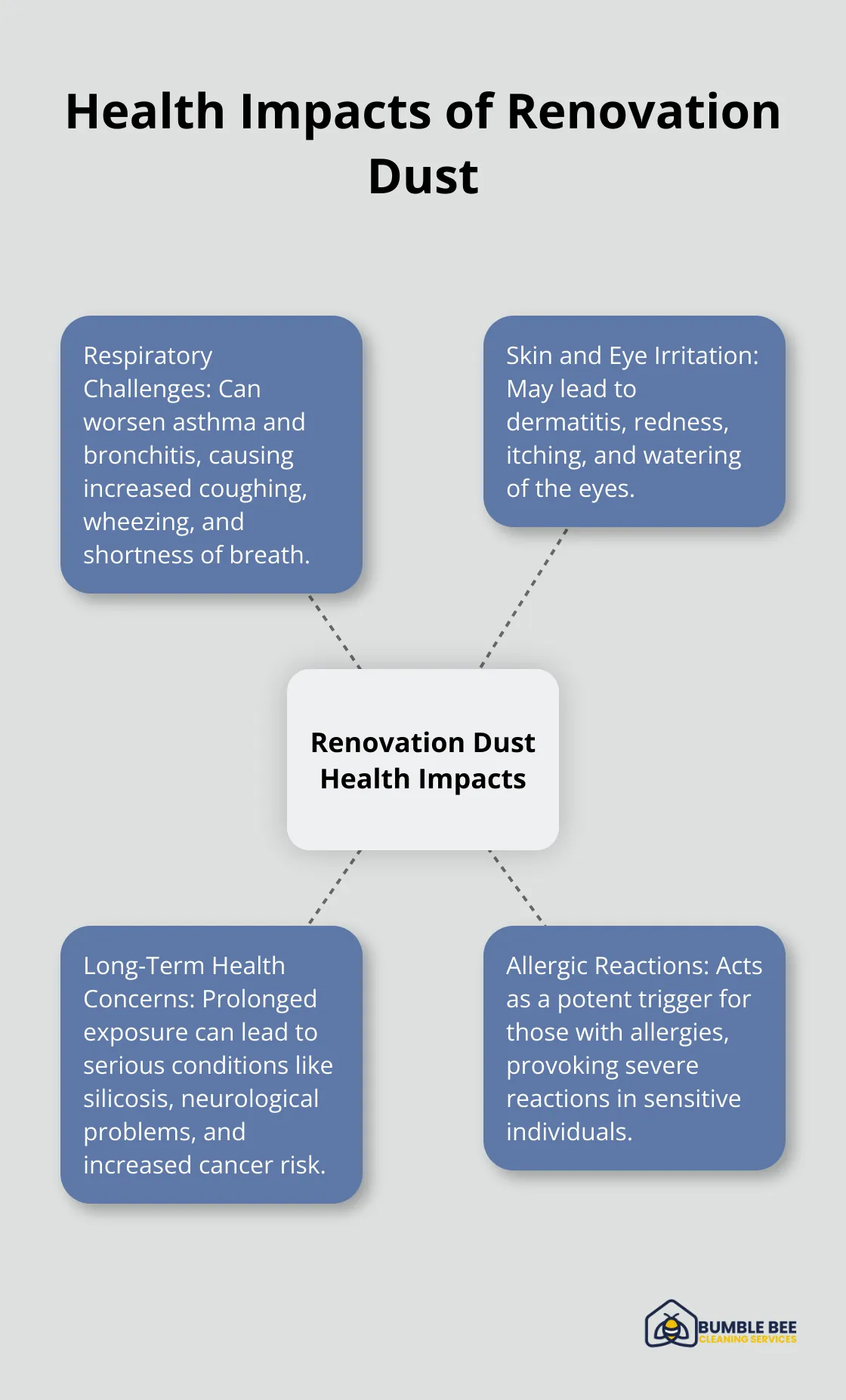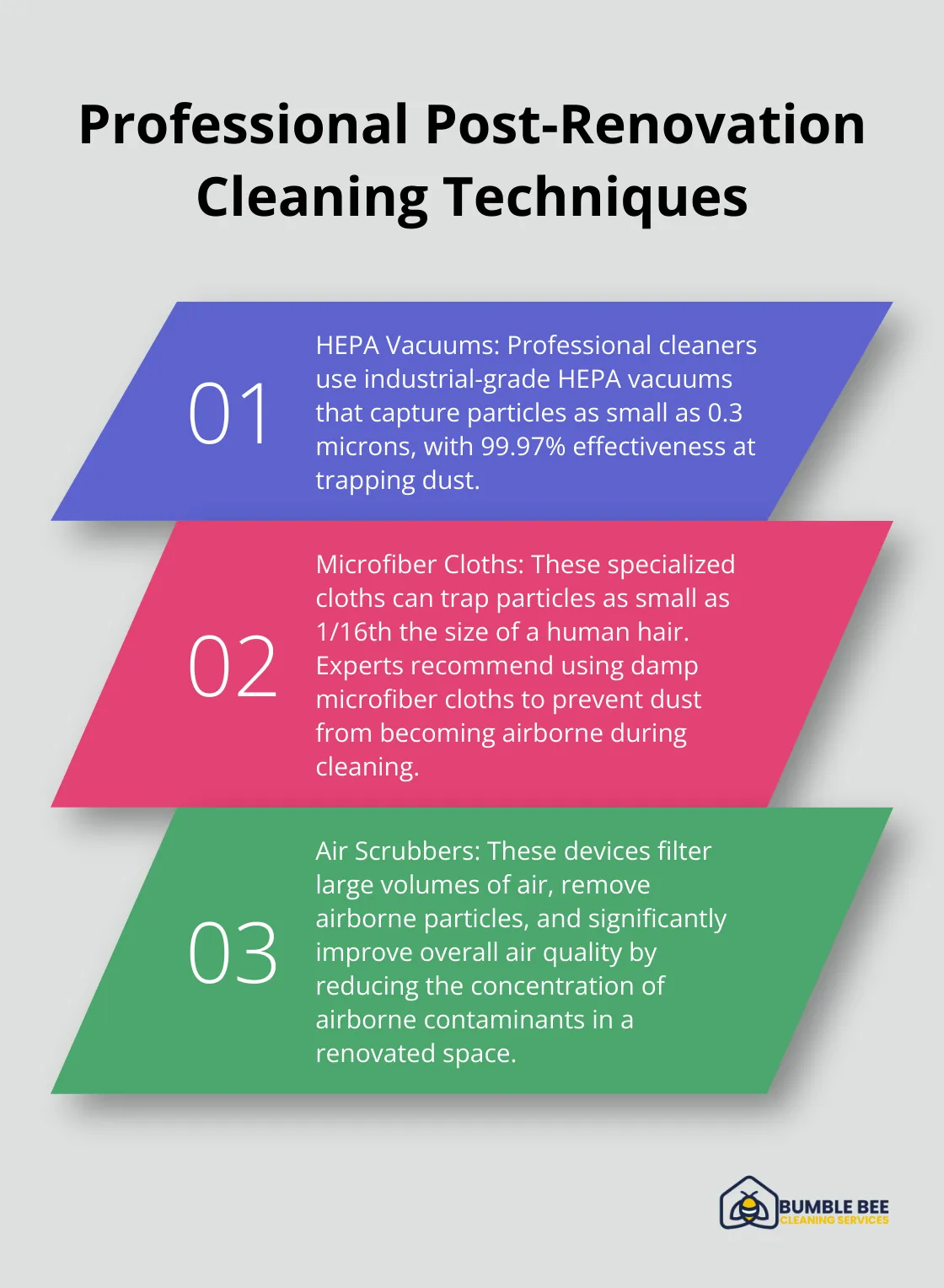Renovating your Seattle home can be exciting, but it often leaves behind a hidden danger: renovation dust. This fine particulate matter is more than just a nuisance; it can pose serious health risks to you and your family.
At Bumble Bee Cleaning Services, we’ve seen firsthand the impact of post-renovation dust on homeowners’ well-being. In this post, we’ll explore why this dust is so hazardous and how to effectively remove it from your living spaces.
What’s in Post-Renovation Dust?
The Composition of Renovation Dust
Post-renovation dust contains a complex mixture of potentially harmful particles that can linger in your Seattle home long after the completion of work. This dust differs significantly from regular household dust, as it contains potentially harmful substances that can impact your health.
Renovation dust typically includes particles from drywall, wood, concrete, and paint. The Environmental Protection Agency (EPA) reports that small particles less than 10 micrometers in diameter pose the greatest problems, because they can get deep into your lungs, and some may even get into your bloodstream.

Common Sources in Home Improvements
Various activities during renovations generate dust. Major culprits include:
- Sanding drywall
- Cutting wood
- Demolishing old structures
Even seemingly minor tasks like drilling holes or removing old wallpaper can release significant amounts of dust into your home’s air.
The Dangers of Renovation Dust
The danger of renovation dust stems from its composition and size. Unlike regular household dust (mostly dead skin cells and fabric fibers), renovation dust often contains silica, asbestos, and lead. These substances can cause serious health issues when inhaled.
Small asbestos fibers get lodged deep in the lungs and increase the risk of lung disease and cancer. Asbestos should be disclosed when you purchase a home, and proper precautions should be taken during renovations.
The Persistence of Renovation Dust
Many homeowners underestimate the amount and persistence of renovation dust. It’s not uncommon to find layers of fine dust weeks after the completion of a renovation project, especially in hard-to-reach areas like air ducts and behind furniture.
To protect your health, you should address post-renovation dust thoroughly and promptly. Professional cleaning services often become necessary to ensure a safe living environment.
The next section will explore the specific health risks associated with this type of dust and why professional cleaning plays a vital role in maintaining a healthy home post-renovation.
How Renovation Dust Impacts Your Health
Respiratory Challenges
Post-renovation dust poses significant health risks that extend beyond mere inconvenience. The fine particles generated during home improvements can lead to a range of health issues, from immediate discomfort to long-term complications.
The American Lung Association reports that fine particles can penetrate deep into the lungs, causing irritation and inflammation. There is no safe threshold for breathing in these particles, and they can worsen existing conditions like asthma and bronchitis, resulting in increased coughing, wheezing, and shortness of breath.
For those with allergies, renovation dust acts as a potent trigger. The Asthma and Allergy Foundation of America notes that dust from drywall, wood, and old insulation can contain allergens that provoke severe reactions in sensitive individuals.
Skin and Eye Irritation
Your lungs are not the only part of your body that suffers from renovation dust. The National Institute for Occupational Safety and Health (NIOSH) has found that contact with certain types of construction dust can lead to dermatitis, a condition characterized by red, itchy skin.
Eye irritation is another common complaint. Dust particles can cause redness, itching, and watering of the eyes. In some cases, this can progress to more serious conditions like conjunctivitis if left untreated.
Long-Term Health Concerns
The potential long-term health effects of prolonged exposure to renovation dust are perhaps most alarming. The Occupational Safety and Health Administration (OSHA) warns that repeated exposure to silica dust (commonly found in concrete and masonry work) can lead to silicosis, a serious lung disease.
Moreover, older homes may contain hazardous materials like lead and asbestos. The EPA cautions that disturbing these materials during renovations can release toxic particles into the air. Long-term exposure to lead dust can cause neurological problems, while asbestos fibers are known carcinogens linked to lung cancer and mesothelioma.

Hidden Dangers in Seattle Homes
Seattle’s housing stock includes many older homes that may contain lead-based paint or asbestos insulation. Most homes built before 1980 contain lead paint and/or asbestos. Renovations in these homes can release these dangerous substances into the air, creating a significant health hazard for residents.
The city’s damp climate also contributes to the problem. Moisture can trap dust particles, allowing them to linger in the air for longer periods. This prolonged exposure increases the risk of respiratory issues and other health problems.
As we move forward, it’s important to understand that while renovation dust poses serious health risks, there are effective methods to remove it and protect your health. The next section will explore these cleaning techniques in detail, helping you maintain a safe and healthy home environment post-renovation.
How to Effectively Remove Post-Renovation Dust
The Professional Advantage
Post-renovation dust in Seattle homes poses serious health risks that require immediate attention. Professional cleaning services offer significant benefits over DIY approaches. Experts possess the knowledge, experience, and equipment to thoroughly remove harmful particles from your home.
Professional cleaners use industrial-grade HEPA vacuums that capture particles as small as 0.3 microns. These vacuums are 99.97% effective at trapping dust, far surpassing the capabilities of typical household vacuums.
Specialized Techniques for Thorough Cleaning
Professional cleaners employ a systematic approach to ensure no area is overlooked. They start from the top and work their way down, which prevents re-contamination of cleaned areas.
One effective technique involves the use of microfiber cloths. These cloths trap particles as small as 1/16th the size of a human hair, making them incredibly effective for post-renovation cleanup. Experts recommend using damp microfiber cloths to prevent dust from becoming airborne during cleaning.
Another specialized method utilizes air scrubbers. These devices filter large volumes of air, remove airborne particles, and improve overall air quality. Air scrubbers can significantly reduce the concentration of airborne contaminants in a renovated space.

Tackling Hard-to-Reach Areas
Post-renovation dust often settles in areas that people easily overlook during regular cleaning. These include HVAC ducts, light fixtures, and the tops of cabinets and door frames.
Professional cleaners have the tools and expertise to access these hard-to-reach areas. They use extended dusters and specialized vacuum attachments to clean ceiling fans and high shelves without spreading dust around.
HVAC systems require particular attention. Air duct cleaning is essential for maintaining clean indoor air and ensuring HVAC efficiency. Over time, dust, mold, and allergens accumulate in ducts, reducing air quality.
The Importance of Thorough Cleaning
Removing post-renovation dust is a complex task that goes beyond regular house cleaning. While DIY methods can help, they often fall short of achieving the thorough cleaning necessary to safeguard your health. Professional services, with their specialized equipment and techniques, offer the most effective solution to this hidden danger in your newly renovated Seattle home.
Final Thoughts
Renovation dust poses a significant threat to the health and well-being of Seattle homeowners. This hidden danger can lead to respiratory issues, skin irritations, and long-term health problems if not properly addressed. The fine particles from construction materials can linger in your home long after the renovation is complete, potentially containing harmful substances like lead and asbestos.
Professional cleaning after renovations is not just about aesthetics; it protects your family’s health. DIY methods often fall short of achieving the thorough cleaning necessary to remove all traces of renovation dust. Professional cleaning services offer the most effective solution to this hidden danger, using specialized tools and expertise to ensure a dust-free home.
We at Bumble Bee Cleaning Services understand the importance of a clean home after renovations. Our team uses industrial-grade equipment and specialized techniques to clean every area of your Seattle home. We pay attention to often-overlooked spaces, providing a comprehensive cleaning solution that goes beyond surface-level tidying.
